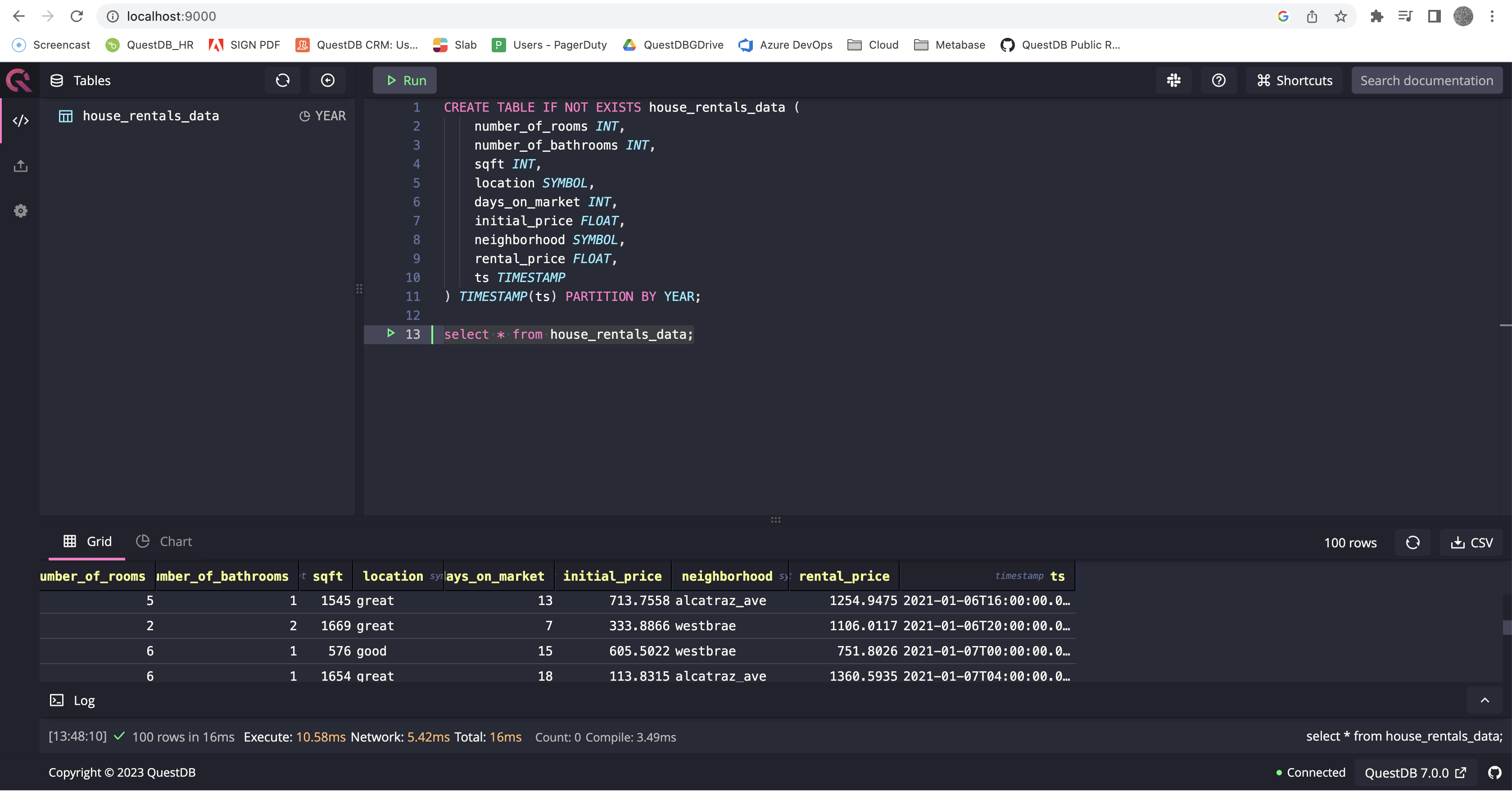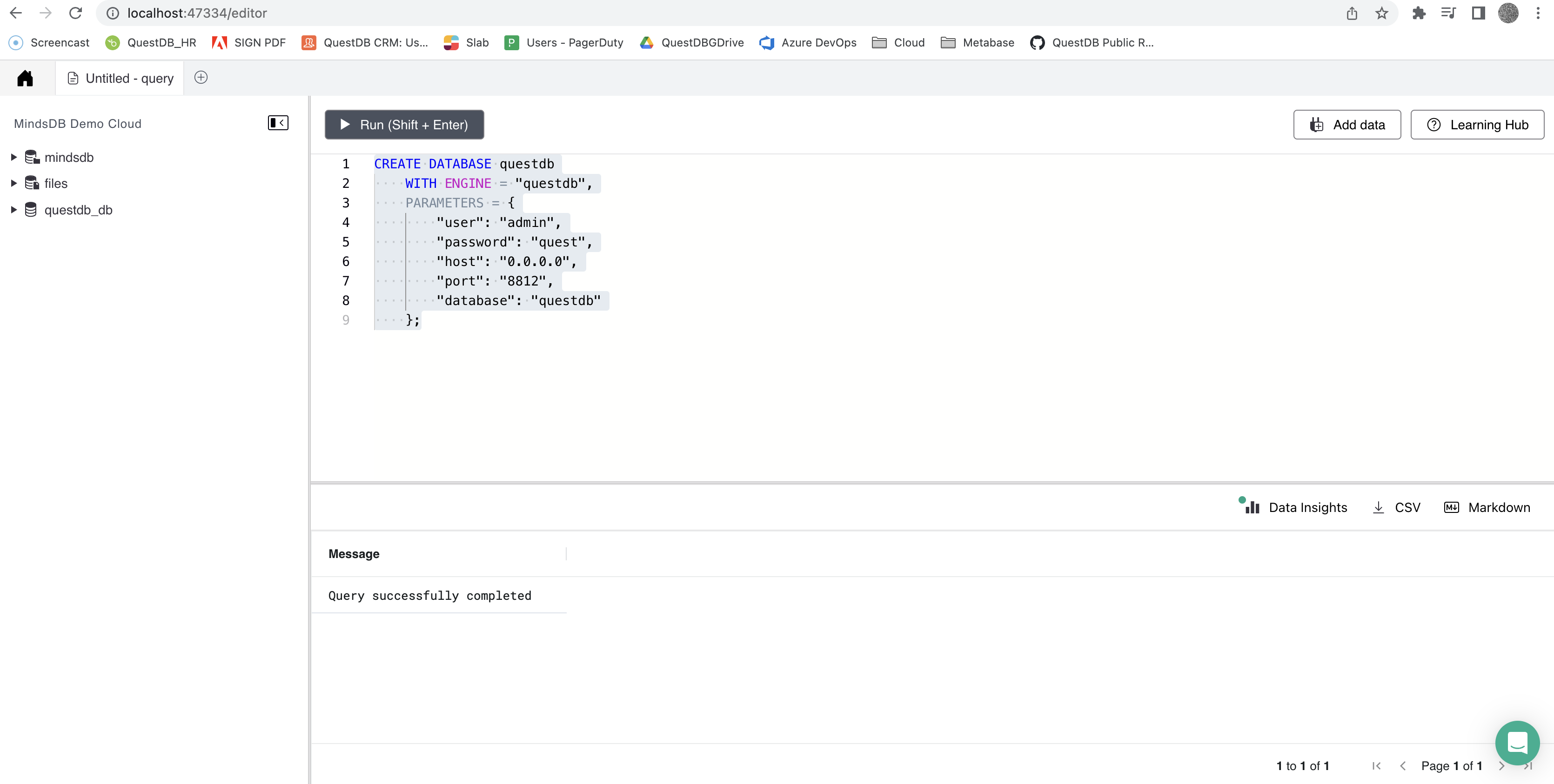MindsDB enables you to use Machine Learning to ask predictive questions about your data and receive accurate answers from it, all in SQL. With MindsDB:
- Developers can quickly add AI capabilities to their applications.
- Data scientists can streamline MLOps by deploying ML models as AI Tables.
- Data analysts can easily make forecasts on complex data, such as multivariate time-series with high cardinality, and visualize these in BI tools like Grafana, and Tableau.
QuestDB is the fastest open-source, column-oriented SQL database for time-series data. It has been designed and built for massively-parallelized vectorized execution and SIMD, as the de-facto backend for high-performance demanding applications in financial services, IoT, IIoT, ML, MLOps, DevOps and observability. QuestDB implements ANSI SQL with additional extensions for time-specific queries, which make it simple to correlate data from multiple sources using relational and time series joins, and execute aggregation functions with simplicity and speed. In addition, QuestDB is resource efficient (comparatively cheaper than other projects to run in cloud environments), simple to install, manage, use, and stable in all production environments.
Combining both MindsDB and QuestDB gives you unbound prediction ability with SQL. You can perform all the pre-processing of your data inside QuestDB using its powerful and unique extended SQL, and then you can access these data from MindsDB, in its own also unique SQL, to produce powerful ML models.
The main goal of this article is to gently introduce these two deep technologies and give you enough understanding to be able to undertake very ambitious ML projects. To that end we will:
- Build a Docker image and spawn a container to run MindsDB and QuestDB together.
- Add QuestDB as a datasource to MindsDB using a SQL Statement.
- Create a table and add data for a simple ML use case using QuestDB's web console.
- Connect to MindsDB using its web console write some SQL.
- Create a predictor for our ML use case.
- Make some predictions about our data.
Have fun!
docker is required to create an image and run our container.
Software repositories in case you are inclined to look under the hood (Give us a star!):
- MindsDB: https://github.com/mindsdb/mindsdb.
- QuestDB: https://github.com/questdb/questdb.
Build the image first, with command:
docker build -t questdb/mindsdb:latest .which allows us to start our service container with command:
docker run --rm \
-p 8812:8812 \
-p 9009:9009 \
-p 9000:9000 \
-p 8888:8888 \
-p 47334:47334 \
-p 47335:47335 \
-d \
--name qmdb \
questdb/mindsdb:latestThe container is run as user quest. It takes about 10 seconds to become responsive, logs can be followed in the terminal:
docker logs -f qmdb
...
http API: starting...
mysql API: starting...
mongodb API: starting...
...
mongodb API: started on 47336
mysql API: started on 47335
http API: started on 47334The container has these mount points:
- /home/quest: User home dir.
- ~/questdb/: QuestDB's root directory.
- ~/questdb/db/: QuestDB's data root directory.
- ~/backups/: Directory for backups.
- ~/csv/: Directory for COPY operation.
- ~/mindsdb/storage/: MindsDB's data root directory.
To manage it as root:
docker run --rm -it --name qmdb-cli -u 0 questdb/mindsdb:latest bashWe can access QuestDB's web console at localhost:9000:
and execute this DDL query to create a simple table (copy this query to the web console, select it and click Run):
CREATE TABLE IF NOT EXISTS house_rentals_data (
number_of_rooms INT,
number_of_bathrooms INT,
sqft INT,
location SYMBOL,
days_on_market INT,
initial_price FLOAT,
neighborhood SYMBOL,
rental_price FLOAT,
ts TIMESTAMP
) TIMESTAMP(ts) PARTITION BY YEAR;We can upload data from a local CSV file to QuestDB:
curl -F data=@sample_house_rentals_data.csv "http://localhost:9000/imp?forceHeader=true&name=house_rentals_data"More information available here!.
We could equally populate table house_rentals_data with random data (excellent tutorial on this):
INSERT INTO house_rentals_data SELECT * FROM (
SELECT
rnd_int(1,6,0),
rnd_int(1,3,0),
rnd_int(180,2000,0),
rnd_symbol('great', 'good', 'poor'),
rnd_int(1,20,0),
rnd_float(0) * 1000,
rnd_symbol('alcatraz_ave', 'berkeley_hills', 'downtown', 'south_side', 'thowsand_oaks', 'westbrae'),
rnd_float(0) * 1000 + 500,
timestamp_sequence(
to_timestamp('2021-01-01', 'yyyy-MM-dd'),
14400000000L
)
FROM long_sequence(100)
);Either way, this gives us 100 data points, one every 4 hours, from 2021-01-16T12:00:00.000000Z (QuestDB's timestamps are UTC with microsecond precision), conveniently downloaded to file sample_house_rentals_data.csv.
NOTE: If you tried the last query, you will have 200 rows, you can truncate table house_rentals_data and run the curl
command again, in QuestDB data are immutable.
We can access MindsDB's web console at localhost:47334:
Only two databases are relevant to us, questdb and mindsdb
SHOW DATABASES;
+--------------------+
| Database |
+--------------------+
| mindsdb |
| files |
| questdb |
+--------------------+
5 rows in set (0.34 sec) To see questdb as a database we need to add it by executing:
CREATE DATABASE questdb
WITH ENGINE = "questdb",
PARAMETERS = {
"user": "admin",
"password": "quest",
"host": "0.0.0.0",
"port": "8812",
"database": "questdb"
};This is a read-only view on our QuestDB instance. We can query it leveraging the full power of QuestDB's unique SQL syntax because statements are sent from MindsDB to QuestDB without interpreting them. It only works for SELECT statements:
SELECT * FROM questdb (
SELECT
ts,
neighborhood,
sum(days_on_market) DaysLive,
min(rental_price) MinRent,
max(rental_price) MaxRent,
avg(rental_price) AvgRent
FROM house_rentals_data
WHERE ts BETWEEN '2021-01-08' AND '2021-01-10'
SAMPLE BY 1d FILL (0, 0, 0, 0)
);
+--------------+----------------+----------+----------+----------+--------------------+
| ts | neighborhood | DaysLive | MinRent | MaxRent | AvgRent |
+--------------+----------------+----------+----------+----------+--------------------+
| 1610064000.0 | south_side | 19 | 1285.338 | 1285.338 | 1285.338134765625 |
| 1610064000.0 | downtown | 7 | 1047.14 | 1047.14 | 1047.1396484375 |
| 1610064000.0 | berkeley_hills | 17 | 727.52 | 727.52 | 727.5198974609375 |
| 1610064000.0 | westbrae | 36 | 1038.358 | 1047.342 | 1042.85009765625 |
| 1610064000.0 | thowsand_oaks | 5 | 1067.319 | 1067.319 | 1067.318603515625 |
| 1610064000.0 | alcatraz_ave | 0 | 0.0 | 0.0 | 0.0 |
| 1610150400.0 | south_side | 10 | 694.403 | 694.403 | 694.4031982421875 |
| 1610150400.0 | downtown | 16 | 546.798 | 643.204 | 595.0011291503906 |
| 1610150400.0 | berkeley_hills | 4 | 1256.49 | 1256.49 | 1256.4903564453125 |
| 1610150400.0 | westbrae | 0 | 0.0 | 0.0 | 0.0 |
| 1610150400.0 | thowsand_oaks | 0 | 0.0 | 0.0 | 0.0 |
| 1610150400.0 | alcatraz_ave | 14 | 653.924 | 1250.477 | 952.2005004882812 |
| 1610236800.0 | south_side | 0 | 0.0 | 0.0 | 0.0 |
| 1610236800.0 | downtown | 9 | 1357.916 | 1357.916 | 1357.9158935546875 |
| 1610236800.0 | berkeley_hills | 0 | 0.0 | 0.0 | 0.0 |
| 1610236800.0 | westbrae | 0 | 0.0 | 0.0 | 0.0 |
| 1610236800.0 | thowsand_oaks | 0 | 0.0 | 0.0 | 0.0 |
| 1610236800.0 | alcatraz_ave | 0 | 0.0 | 0.0 | 0.0 |
+--------------+----------------+----------+----------+----------+--------------------+Beyond SELECT statements, for instance when we need to save the results of a query into a new table, we need to use QuestDB's web console available at localhost:9000:
CREATE TABLE sample_query_results AS (
SELECT
ts,
neighborhood,
sum(days_on_market) DaysLive,
min(rental_price) MinRent,
max(rental_price) MaxRent,
avg(rental_price) AvgRent
FROM house_rentals_data
WHERE ts BETWEEN '2021-01-08' AND '2021-01-10'
SAMPLE BY 1d FILL (0, 0, 0, 0)
) TIMESTAMP(ts) PARTITION BY MONTH;Contains the metadata tables necessary to create ML models:
USE mindsdb;
SHOW TABLES;
+-------------------+
| Tables_in_mindsdb |
+-------------------+
| models |
| models_versions |
+-------------------+We can create a predictor model mindsdb.home_rentals_model_ts to predict the rental_price
for a neighborhood considering the past 20 days, and no additional features:
CREATE MODEL mindsdb.home_rentals_model_ts FROM questdb (
SELECT
neighborhood,
rental_price,
ts
FROM house_rentals_data
)
PREDICT rental_price ORDER BY ts GROUP BY neighborhood
WINDOW 20 HORIZON 1;This triggers MindsDB to create/train the model based on the full data available from QuestDB's table
house_rentals_data (100 rows) as a timeseries on column ts.
You can see the progress by monitoring the log output of the mindsdb Docker container. Creating/training a
model will take time proportional to the number of features, i.e.cardinality of the source table as defined
in the inner SELECT of the CREATE PREDICTOR statement, and the size of the corpus, i.e. number of rows. The
model is a table in MindsDB:
SHOW TABLES;
+-----------------------+
| Tables_in_mindsdb |
+-----------------------+
| information_schema |
| models |
| model_versions |
| home_rentals_model_ts |
+-----------------------+We can get more information about the trained model, how was the accuracy calculated or which columns are important for the model by executing the DESCRIBE statement.
DESCRIBE MODEL mindsdb.home_rentals_model_ts;
*************************** 1. row ***************************
accuracies: {'complementary_smape_array_accuracy':0.859}
outputs: ['rental_price']
inputs: ['neighborhood', 'ts', '__mdb_ts_previous_rental_price']
datasource: home_rentals_model_ts
model: encoders --> dtype_dict --> dependency_dict --> model --> problem_definition --> identifiers --> imputers --> accuracy_functionsOr, to see how the model encoded the data prior to training we can execute:
DESCRIBE MODEL mindsdb.home_rentals_model_ts.features;
+--------------+-------------+------------------+---------+
| column | type | encoder | role |
+--------------+-------------+------------------+---------+
| neighborhood | categorical | OneHotEncoder | feature |
| rental_price | float | TsNumericEncoder | target |
| ts | datetime | ArrayEncoder | feature |
+--------------+-------------+------------------+---------+Additional information about the models and how they can be customized can be found on the Lightwood docs.
The latest rental_price value per neighborhood in table questdb.house_rentals_data
(as per the uploaded data) can be obtained directly from QuestDB
executing query:
SELECT * FROM questdb (
SELECT
neighborhood,
rental_price,
ts
FROM house_rentals_data
LATEST BY neighborhood
);
+----------------+--------------+--------------+
| neighborhood | rental_price | ts |
+----------------+--------------+--------------+
| thowsand_oaks | 1150.427 | 1610712000.0 | (2021-01-15 12:00:00.0)
| south_side | 726.953 | 1610784000.0 | (2021-01-16 08:00:00.0)
| downtown | 568.73 | 1610798400.0 | (2021-01-16 12:00:00.0)
| westbrae | 543.83 | 1610841600.0 | (2021-01-17 00:00:00.0)
| berkeley_hills | 559.928 | 1610870400.0 | (2021-01-17 08:00:00.0)
| alcatraz_ave | 1268.529 | 1610884800.0 | (2021-01-17 12:00:00.0)
+----------------+--------------+--------------+To predict the next value:
SELECT
tb.ts,
tb.neighborhood,
tb.rental_price as predicted_rental_price,
tb.rental_price_explain as explanation
FROM questdb.house_rentals_data AS ta
JOIN mindsdb.home_rentals_model_ts AS tb
WHERE ta.ts > LATEST;
+---------------------+----------------+------------------------+------------------------------------------------------------------------------------------------------------------------------------------------------------------------------------------+
| ts | neighborhood | predicted_rental_price | explanation |
+---------------------+----------------+------------------------+------------------------------------------------------------------------------------------------------------------------------------------------------------------------------------------+
| 2021-01-17 00:00:00 | downtown | 877.3007391233444 | {"predicted_value": 877.3007391233444, "confidence": 0.9991, "anomaly": null, "truth": null, "confidence_lower_bound": 379.43294697022424, "confidence_upper_bound": 1375.1685312764646} |
| 2021-01-19 08:00:00 | westbrae | 923.1387395936794 | {"predicted_value": 923.1387395936794, "confidence": 0.9991, "anomaly": null, "truth": null, "confidence_lower_bound": 385.8327438509463, "confidence_upper_bound": 1460.4447353364124} |
| 2021-01-15 16:00:00 | thowsand_oaks | 1418.678199780345 | {"predicted_value": 1418.678199780345, "confidence": 0.9991, "anomaly": null, "truth": null, "confidence_lower_bound": 1335.4600013965369, "confidence_upper_bound": 1501.8963981641532} |
| 2021-01-17 12:00:00 | berkeley_hills | 646.5979284300436 | {"predicted_value": 646.5979284300436, "confidence": 0.9991, "anomaly": null, "truth": null, "confidence_lower_bound": 303.253838410034, "confidence_upper_bound": 989.9420184500532} |
| 2021-01-18 12:00:00 | south_side | 1422.69481363723 | {"predicted_value": 1422.69481363723, "confidence": 0.9991, "anomaly": null, "truth": null, "confidence_lower_bound": 129.97617491441304, "confidence_upper_bound": 2715.413452360047} |
| 2021-01-18 04:00:00 | alcatraz_ave | 1305.009073065412 | {"predicted_value": 1305.009073065412, "confidence": 0.9991, "anomaly": null, "truth": null, "confidence_lower_bound": 879.0232742685288, "confidence_upper_bound": 1730.994871862295} |
+---------------------+----------------+------------------------+------------------------------------------------------------------------------------------------------------------------------------------------------------------------------------------+In this article, we have introduced QuestDB and MindsDB in a hands-on approach. QuestDB can help you store, analyse, and transform timeseries data, while MindsDB can help you make predictions about it. Albeit simple, our use case should have lowered the entry barrier to these two deep technologies, and now you can deepen your knowledge further by undertaking more ambitious ML projects.
Thank you for getting this far!!!, if you liked this content we'd love to know your thoughts, please come and say hello in our welcoming communities:
Further reading:
See you soon!

